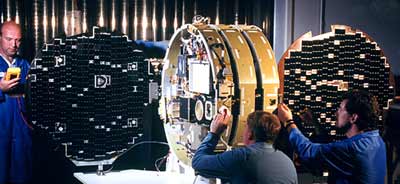Thank you very much for visiting Gunter's Space Page. I hope that this site is useful and informative for you.
If you appreciate the information provided on this site, please consider supporting my work by making a simple and secure donation via PayPal. Please help to run the website and keep everything free of charge. Thank you very much.
BATSAT (Teledesic T1)

BATSAT (Teledesic T1) [OSC]
The T1 satellite, previously passing under the pseudonym BATSAT (Broadband Advanced Technologies Satellite), was purely a demonstration satellite for the Teledesic constellation. The satellite was significantly different in size and design from the final constellation of 288 satellites. However, T1 supported two-way communications at speeds up to E1 rates.
T1 was placed in at low earth orbit at a 565 kilometer altitude via a Pegasus-XL air-launched booster, dropped from Orbital's Stargazer, L-1011 carrier aircraft. The satellite became part of research already underway on the ground into software simulation and hardware development.
Key areas under scrutiny from Orbital's ground-control station in Dulles, Va., were atmospheric drag, radio frequency uplink and downlink power control, Ka-band atmospheric propagation delay, global positioning system synchronization analysis, laser-link stability, and sun and moon interference.
The payload was supplied by Boeing, with Orbital contributing its light-weight, low-cost MicroStar bus specifically designed for use with the Pegasus launcher. The MicroStar was scaled up by a factor of three for T1 from the standard model.
Teledesic and Boeing were keeping progress under wraps on the largest of their projects. They did not issue status reports on the experimental satellite, but confirmed that more demonstration "birds" were to be launched in the coming months, which eventually did not happen.
T1 was the first Ka-band satellite in orbit owned by a commercial enterprise, and one important area of testing was frequency performance in the 28.6 GHz to 29.1 GHz band. Teledesic officially won the right to Ka bandwidth frequencies last November after a long political struggle with rival satellite-communications consortia. Some analysts had questioned the downlink performance of such high frequencies during rainfall, however, saying Teledesic's rainfade margin would not be sufficient for users with small receiver dishes.
BATSAT decayed from orbit on 9 October 2000.
| Nation: | USA |
|---|---|
| Type / Application: | Experimental Communication |
| Operator: | Teledesic |
| Contractors: | Orbital Sciences Corporation (OSC) |
| Equipment: | Ka-band transponder |
| Configuration: | MicroStar (triple) |
| Propulsion: | ? |
| Power: | 2 deployable solar arrays, batteries |
| Lifetime: | 2.5 years |
| Mass: | 120 kg |
| Orbit: | 580 km × 535 km, 97.7° |
| Satellite | COSPAR | Date | LS | Launch Vehicle | Remarks | |
|---|---|---|---|---|---|---|
| BATSAT (Teledesic T1) | 1998-012B | 26.02.1998 | Va, L-1011 | Pegasus-XL | with SNOE |
